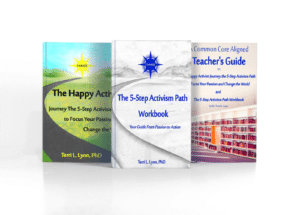- The Meaning of Critical Thinking: A Key Skill for Navigating Today’s Information Landscape - November 3, 2025
- Grandparents Can Develop Activist Grandchildren - September 29, 2025
- Top Six Reasons Credit Union Benefits Are a Smart Choice Over Banks - August 18, 2025
Last Updated on September 29, 2025
In this post, I share effective activism strategies for beginners. Then, I encourage you to consider your metaphorical protest sign.
In the previous posts leading up to the launch of The Happy Activist (formerly What’s On Your Sign?), I walked you through the 5-Step Activism Path.
- Find Your Passion
- Clarify Your Unique Skills
- Find Activism You Love
- Find Your Perfect Activism Opportunity
In Step 5, I help you get ready for your own launch. You’ll be well prepared for your perfect activism opportunity with a thoughtful approach that includes effective activism strategies for beginners.
In this video Burt realizes that he has found the perfect activism opportunity. But he needs to be better prepared.
Burt sets himself up for success by anticipating obstacles, setting goals, and understanding how he reacts to stress. The result: engagement and impact for his cause.
Set Yourself Up For Success: Effective Activism Strategies for Beginners
In Step 5, you prepare yourself for success with an action plan that includes maximizing your performance, setting goals, and creating a stress management plan. Oh, and celebrating!
Maximize Your Performance

To make sure you are successful, do activism work that rewards you. If you built in your top personal motivation, that is a great start. Occasionally, everyone needs to help with tasks that are not fun. But most of your work should engage you.
Do you have the right tools to do your job? And what obstacles are in your way? Removing potential obstacles improves the chance of success.
Create an Action Plan
Set clear, achievable goals to keep yourself motivated and on track. Break larger objectives into smaller, manageable tasks. Have a few SMART goals in place as you begin your work, like the one below:
- Specific: I will lobby my state elected officials about broad LGBTQIA+ issues and about any LGBTQIA+ bills filed.
- Measurable: I will discuss the issues with my representative in person, if possible.
- Achievable: I will plan trips to the state capital when my representatives are in session. I will travel for emergency lobbying if I can; otherwise, I will contact their local offices.
- Relevant: This is the area I identified in my planning process.
- Timely: My planned trips will be in April and September. My emergency lobbying will be as needed.
Stay Motivated

Recognize what you need to do to take care of yourself. Ensure your self-care so your cause receives the benefit of your best work.
Understand How Your Body Reacts to Stress
Recognize how you react to stress before it becomes overwhelming. You experience tension in your body. It is your body telling you to relax and slow down. I experience stress in my stomach, and many people report getting head and neck aches. Where does it happen for you?
Use Coping Strategies
Once you recognize stress building in your body, use a coping strategy to help you relax before it becomes overwhelming.
Manage Your Emotions
Self-care activities to manage your emotions are reading, writing, and listening to music. Physical movement and exercise can help, too.
Manage Your Thinking
Control your reactions to events by training your mind to interpret them more rationally and positively. This may include disputing negative self-talk, making your default reactions positive rather than negative, and using logic rather than emotions.
For example, if your friend doesn’t respond to an email you sent, you can use a rational approach and interpret it as “She must be busy.” The irrational approach is, “She must be mad at me.” Instead of feeling anxious or angry, you can feel calm and hopeful.
Manage the Situation
Coping strategies also include managing the situation that is causing you stress. Setting boundaries, improving your time management, and finding social support are ways to deal with stressful situations.
- Setting Boundaries: Boundaries protect your right to be treated with respect and kindness, say no, be physically and emotionally safe, and have your own feelings, values, and beliefs. Healthy boundaries lead to better relationships and mental well-being.
- Improve Your Time Management: Shoring up your time management skills is also a way to manage a situation that is causing stress. For example, something as simple as reviewing your priorities can help you focus on what is truly important.
- Use Your Support Network: Your support network can help you cope with stress. Spend time with those who guide you to an emotionally healthy life.
Celebrate
Importantly, don’t forget to celebrate!
Celebrating your efforts is a way of nurturing yourself. It also helps your cause by keeping you motivated for future work.
Effective Activism Strategies for Beginners: Turning Your Passion into Action

- Create a Vision Board: Create a vision board that represents your passions and goals. Cut out images and words that inspire you and create a visual representation of your goals. I did this, and it was really a fun project. And years later, I still take time to get inspired by it.
- Start a Learning Journal: Dedicate a notebook or digital document to your activist education. Record insights, questions, and ideas as you delve deeper into your cause.
- Connect with Others: Activism is often more effective when done in collaboration with others. Seek out individuals and organizations that share your passion and goals. Working together can amplify your efforts and create a more significant impact.
- Find a Mentor: As you connect with others, consider finding a mentor. Their guidance can help you refine your focus and avoid common pitfalls. Later, you might find yourself mentoring a new activist!
- Practice Saying No: Saying “No” is a way of setting boundaries that protect your mental health. As you clarify your focus, learn to politely decline requests that don’t align with your life vision. This skill is crucial for maintaining your focus and energy.
- Regularly Reassess: Set aside time every few months to evaluate your focus. Are you still passionate about your activism? Are your efforts making the impact you hoped for? Be open to refining your focus as you grow and learn.
What’s On Your Metaphorical Protest Sign?
On August 19, 2024, I launched the second edition of What’s On Your Sign? but I renamed it The Happy Activist. Why did I change the name? Because people have confused my book with astrology books. Another reason is that I like the idea of using a protest sign message to refine your vision, but I don’t recommend protests as an activism method for anything other than mobilization.
Finally, I learned in the years since I published the first edition that my 5-Step Activism Path makes people happy, which is not how people traditionally view activists.

Basically, they find their purpose, and that makes them happy. And when they know the cause closest to their heart, they are better able to focus their passion. That makes fitting activism into their life easy.
But I’m not giving up on asking, “What’s On Your Sign?” Craft a clear, concise statement that encapsulates your focused activist goal. This will serve as a touchstone to keep you aligned with your purpose. Creating your metaphorical protest sign helps you refine what you stand for and is a tool to amplify your voice and impact. It should be the core of your activism elevator speech.
So, what’s on your metaphorical protest sign?
Announcement

In addition, The What’s On Your Sign? Workbook has also been updated and renamed The 5-Step Activism Path Workbook. I designed the workbook to provide readers with actionable steps and exercises that align with The Happy Activist. It’s the perfect tool for anyone looking to deepen their engagement and make a more meaningful impact.
To support educators and community leaders, I have developed a Common Core-aligned Teacher’s Guide. This resource provides lesson plans, activities, and discussion prompts to inspire and empower the next generation of activists.
About The Happy Activist
READ NEXT
How To Use a Compassion Fatigue Test to Battle Burnout



